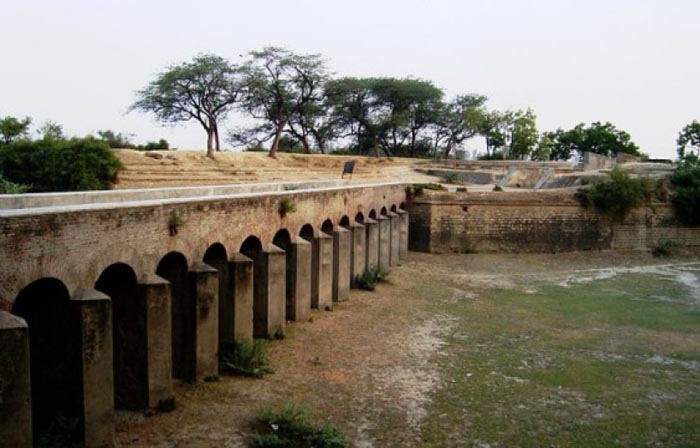Aligarh Fort

Information on Aligarh Fort (Aligarh, Uttar Pradesh) - History & Architecture
Aligarh Fort which is also acknowledged as 'Aligarh Quila' or 'Baunasaur Quila' or 'Ramgarh Quila' is one of the resilient forts of India. Situated in Aligarh of Uttar Pradesh, Aligarh Fort was created by Muhammad, the son of the superintendent of Kol in Umar. The fort was created in the year 1525, which was during the sovereignty of Ibrahim Lodhi, the last ruler of Lodi family and the sultan of Delhi.
Aligarh Fort Architecture
Aligarh Fort possesses attractive French architectural style. The fort is created according to regular polygon structure, surrounded by a deep and extensive trench. The construction of Aligarh Fort comprises about 30 feet high valleys on every sides and the supports are built on the angels of the walls. The fort is situated on the top of the mountain with a vertical gorge on the edges in the centre of Aligarh city. Traditionally, Aligarh Fort had distinctive explosives granary and an air conditioned kitchen. Furthermore, at present, there is a basement in the fort which is not much perceptible from outside. The design of the fort highpoint the ancient architectural demonstration which made it possible to develop a polygonal structure. At present, the internal yard of Aligarh Fort possesses a botanical garden and several other plantations.
Aligarh Fort History
Aligarh Fort was created by the son of the superintendent of Umar. At later phase, the fort was again reconstructed the Sabit Khan, who was the later superintendent of Umar during the sovereignty of Farrukh Siyar as well as Muhammad Shah. In the year 1759, Aligarh Fort gained great importance under Madhavrao Scindia also termed as Mahadji Shinde. He was the Maratha ruler of Gwalior of central India. On that time, the fort was used by Madhavrao Scindia in order to military exercise and to organise the battalions according to European style, with the assistance of French combatant. Nevertheless, throughout the 'Battle of Ally Ghur', also termed as the 'Battle of Aligarh' that was fought between Maratha rulers and the British East India Company, Aligarh Fort was captured by British military. It was during the period of 1803 to 1805 when French officer assisted in the capture of Aligarh Fort from Maratha. However, during the rebellion of 1857, the British troops positioned at Aligarh Fort rampaged against their officers, but not murdered the. As a result, Marathas successfully captured the Aligarh Fort.
Nowadays, Aligarh Fort is controlled by the Aligarh Muslim University, a public university subsidised by the central government of India. The university uses a portion of inner area in order to position Aligarh Fort for the purpose of housing the division of Botany. Aligarh Fort has been the base of various councils and the rulers of the land. Apart from Sabit Khan, Muhammad, Madhavrao Scindia and British rulers, Aligarh Fort was also captured by Surajmal Jat in the year 1753, who was the sovereign of Bharatpur in Rajastan. Moreover, the fort was expanded three times in the year 1753 by lieutenant Banasaur and commanding major of Surajmal Jat in order to add an underground room, an explosive granary and an air conditioned kitchen.
Aligarh Fort Tourism Importance
Aligarh Fort is definitely an important tourist place due to its attractive sight. It has rich history concerning the rulers and is an interesting place from the viewpoint of tourism. The fort boasts various Indian and French architectural styles and is a key specimen of 14th century construction. In other words, this fort stands a vital structure of British era where travellers can enjoy the inner glamour.
- Andaman Nicobar Monuments
- Andhra Pradesh Monuments
- Assam Monuments
- Bihar Monuments
- Chhattisgarh Monuments
- New Delhi Monuments
- Goa Monuments
- Gujarat Monuments
- Haryana Monuments
- Himachal Pradesh Monuments
- Jammu and Kashmir Monuments
- Karnataka Monuments
- Kerala Monuments
- Madhya Pradesh Monuments
- Maharashtra Monuments
- Odisha Monuments
- Punjab Monuments
- Rajasthan Monuments
- Tamil Nadu Monuments
- Telangana Monuments
- Uttar Pradesh Monuments
- West Bengal Monuments